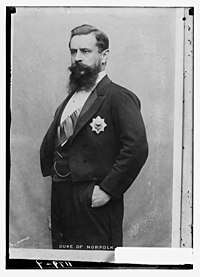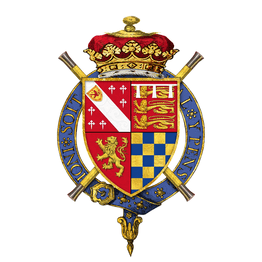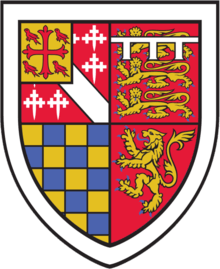Henry Fitzalan-Howard, 15th Duke of Norfolk
Henry Fitzalan-Howard, 15th Duke of Norfolk, KG, GCVO, VD, PC (27 December 1847 – 11 February 1917), styled Baron Maltravers until 1856 and Earl of Arundel and Surrey between 1856 and 1860, was a British Unionist politician and philanthropist. He served as Postmaster General between 1895 and 1900, but is best remembered for his philanthropic work, which concentrated on Roman Catholic causes and the city of Sheffield.
The Duke of Norfolk | |
|---|---|
 Henry Fitzalan-Howard (about 1890) | |
| Earl Marshal | |
| In office 25 November 1860 – 11 February 1917 | |
| Monarch | |
| Preceded by | The 14th Duke of Norfolk |
| Succeeded by | The 16th Duke of Norfolk |
| Postmaster General | |
| In office 6 July 1895 – 10 April 1900 | |
| Monarch | |
| Prime Minister | The Marquess of Salisbury |
| Preceded by | Arnold Morley |
| Succeeded by | The Marquess of Londonderry |
| Personal details | |
| Born | 27 December 1847 |
| Died | 11 February 1917 (aged 69) |
| Nationality | British |
| Political party | Conservative |
| Spouse(s) | (1) Lady Flora Abney-Hastings (1854–1887) (2) Gwendolen Constable-Maxwell (1877–1945) |
| Children | Philip Fitzalan-Howard, Earl of Arundel and Surrey Lady Mary Rachel Fitzalan-Howard Bernard Fitzalan-Howard, 16th Duke of Norfolk Lady Katherine Fitzalan-Howard Lady Winifred Fitzalan-Howard |
| Parents | Henry Fitzalan-Howard, 14th Duke of Norfolk Hon. Augusta Lyons |

Background
Norfolk was the eldest son of Henry Fitzalan-Howard, 14th Duke of Norfolk, and Augusta Mary Minna Catherine, younger daughter of Edmund Lyons, 1st Baron Lyons. Edmund Fitzalan-Howard, 1st Viscount Fitzalan of Derwent, was his younger brother.[1] The Duke was first educated at The Oratory School, but owing to restrictions from the Catholic Hierarchy he was unable to attend either Oxford or Cambridge Universities. His higher education instead consisted of a Grand Tour of Europe around 1867 under the guidance of classical scholar and biographer Robert Ornsby.
Public career
Norfolk succeeded to the dukedom at the age of 12 on the death of his father 25 November, 1860. He also succeeded to the hereditary office of Earl Marshal held by the Dukes of Norfolk.
In 1895 he was sworn of the Privy Council and appointed Postmaster General[2] by Lord Salisbury, a post he held until early 1900, when he resigned in order to serve in the Boer War.[3] In 1895 he also became Mayor of Sheffield; serving two terms during which he arranged the city's monumental celebrations in honour of Queen Victoria's Diamond Jubilee in 1897. Shortly thereafter he was appointed the first Lord Mayor of Sheffield, but retained the office only until November 1897. He was appointed an honorary Freeman of the City of Sheffield three years later.[4] In November 1900 he became the first Mayor of Westminster[5] and, at age 53, went to the Second Boer War as a lieutenant colonel in the Imperial Yeomanry,[6] in the course of which he was wounded near Pretoria and invalided back to Britain.
In his capacity as Earl Marshal he arranged the state funerals of William Ewart Gladstone (1898), Queen Victoria (1901), and King Edward VII (1910), and the coronations of Edward VII (1902) and George V (1911).[7][8]
Apart from serving as Earl Marshal between 1860 and 1917, Norfolk was Lord Lieutenant of Sussex between 1905 and 1917.
He was made a Knight of the Garter in 1886,[9] and received the Knight Grand Cross of the Royal Victorian Order (GCVO) from King Edward VII on 11 August 1902, following the King's coronation two days earlier.[10][11]
He was three time chairman of the National Union of Conservative Associations, grand chancellor of the Primrose League, and commanding officer of the 4th (Volunteer) Battalion Royal Sussex Regiment.[8]
Philanthropy and Religious Work

As is common with the Dukes of Norfolk (but exceptional within the British aristocracy), Norfolk was a Roman Catholic. In his dual role as Premier Duke and most prominent Roman Catholic in England, he undertook a programme of philanthropy which served in part to reintegrate Roman Catholics into civic life. He was born a generation after the Catholic Relief Act 1829 but before the reconstitution of Roman Catholic dioceses in 1850. By the time he came of age as Duke in 1868, the process of Catholic Emancipation had made the establishment of Catholic institutions legal, but the reality of two hundred years of legislation in favour of the Church of England left Roman Catholics with few structures of their own.
Norfolk's first major benefaction commemorated his coming of age as Duke. At his ancestral seat of Arundel Castle (being also one of the Earls of Arundel), he sponsored the construction of the Church of Our Lady and St Philip Neri between 1868 and 1873. This church was later chosen to serve as Arundel Cathedral in 1965 and rededicated in 1971 to include Saint Philip Howard, 20th Earl of Arundel, one of his ancestors.[13]
In 1877, he married his first wife, Lady Flora Hastings. He later wrote, 'Shortly after my most happy marriage, I wished to build a church as a thank-offering to God.' To commemorate this occasion, he undertook construction of a church in his titular ancestral seat in Norwich, Norfolk. After commencing in 1882 with a gift of £200,000, construction would not be completed until 1910, nearly 23 years after Lady Flora's death in 1887. This church was also later chosen to serve as St John the Baptist Cathedral, Norwich when the Roman Catholic Diocese of East Anglia was re-established in 1976.
In the 1890s Norfolk was instrumental in the campaign that convinced the Vatican authorities to relax its restrictions on Catholic students enrolling at the great English universities, culminating with the co-founding of St Edmund's College, Cambridge along with Baron Anatole von Hugel. He was a significant contributor to the Father Damien fund to fight leprosy. He also donated funds for the building of the University of Sheffield and was its initial Chancellor between 1905 and 1917.
From 1898 on, he edited, together with Charles Tindal Gatty, the hymnal Arundel Hymns, to which Pope Leo XIII contributed a preface in form of a personal letter.[14]
Family
In 1877, Norfolk married as his first wife, Lady Flora Paulyna Hetty Barbara Abney-Hastings (1854–1887), daughter of Charles Abney-Hastings, 1st Baron Donington and Edith Rawdon-Hastings, 10th Countess of Loudoun, in 1877. They had one child:
- Philip Joseph Mary Fitzalan-Howard, Earl of Surrey, Earl of Arundel (7 September 1879 – 8 July 1902), died unmarried.
After Lady Flora's death from Bright's Disease in April 1887, aged 33, he remained unmarried for nearly seventeen years.
On 7 February 1904,[15][16] at age 56, he married, as his second wife, his first cousin once removed, the Hon. Gwendolen Constable-Maxwell, eldest daughter of Marmaduke Constable-Maxwell, 11th Lord Herries of Terregles and the Hon. Angela Mary Charlotte, daughter of Edward Fitzalan-Howard, 1st Baron Howard of Glossop. She was 30 years his junior, and aged 27 at their wedding. They had four children:
- Lady Mary Rachel Fitzalan-Howard (27 June 1905 – 17 August 1992)
- Bernard Fitzalan-Howard, 16th Duke of Norfolk (1908–1975)
- Lady Katherine Mary Fitzalan-Howard, (1912–2000)
- Lady Winifred Alice Fitzalan-Howard, (31 October 1914 – 27 May 2006)
In 1908 Gwendolen succeeded her father as Lady Herries of Terregles. The Duke of Norfolk died in February 1917, aged 69, and was succeeded in the dukedom by his only surviving son, Bernard. On his death, Lord Curzon said he was a man "who was diffident about powers which were in excess of the ordinary". The Duchess of Norfolk died in August 1945, aged 68. She was succeeded in the Scottish lordship of parliament by her son, Bernard.[1]
Ancestry
| Ancestors of Henry Fitzalan-Howard, 15th Duke of Norfolk | |||||||||||||||||||||||||||||||||||||||||||||||||||||||||||||||||||||||||||||||||||||||||||||||||||||||||||||||||||||||||||||||||||||||||||||||||||||||||||||||||||||||||||||||||||||||||||||||||||||||||||||||||||||||||||||||||||||||||||||||||||||||||||||||||||||||||||||||||||||||||||||||||||||||||||||||||||||||||||||||||||||||||||||||||||||||||||||||||||||||||||||||||||||||||||||||||||||||||||||||||||||||||||||||||||||||||||||||||||||||||||||||||||||||||||||||||||||||||||||||||||||||||||||||||||||||||||||||||||||||||||||||||||||||||||||
|---|---|---|---|---|---|---|---|---|---|---|---|---|---|---|---|---|---|---|---|---|---|---|---|---|---|---|---|---|---|---|---|---|---|---|---|---|---|---|---|---|---|---|---|---|---|---|---|---|---|---|---|---|---|---|---|---|---|---|---|---|---|---|---|---|---|---|---|---|---|---|---|---|---|---|---|---|---|---|---|---|---|---|---|---|---|---|---|---|---|---|---|---|---|---|---|---|---|---|---|---|---|---|---|---|---|---|---|---|---|---|---|---|---|---|---|---|---|---|---|---|---|---|---|---|---|---|---|---|---|---|---|---|---|---|---|---|---|---|---|---|---|---|---|---|---|---|---|---|---|---|---|---|---|---|---|---|---|---|---|---|---|---|---|---|---|---|---|---|---|---|---|---|---|---|---|---|---|---|---|---|---|---|---|---|---|---|---|---|---|---|---|---|---|---|---|---|---|---|---|---|---|---|---|---|---|---|---|---|---|---|---|---|---|---|---|---|---|---|---|---|---|---|---|---|---|---|---|---|---|---|---|---|---|---|---|---|---|---|---|---|---|---|---|---|---|---|---|---|---|---|---|---|---|---|---|---|---|---|---|---|---|---|---|---|---|---|---|---|---|---|---|---|---|---|---|---|---|---|---|---|---|---|---|---|---|---|---|---|---|---|---|---|---|---|---|---|---|---|---|---|---|---|---|---|---|---|---|---|---|---|---|---|---|---|---|---|---|---|---|---|---|---|---|---|---|---|---|---|---|---|---|---|---|---|---|---|---|---|---|---|---|---|---|---|---|---|---|---|---|---|---|---|---|---|---|---|---|---|---|---|---|---|---|---|---|---|---|---|---|---|---|---|---|---|---|---|---|---|---|---|---|---|---|---|---|---|---|---|---|---|---|---|---|---|---|---|---|---|---|---|---|---|---|---|---|---|---|---|---|---|---|---|---|---|---|---|---|---|---|---|---|---|---|---|---|---|---|---|---|---|---|---|---|---|---|---|---|---|---|---|---|---|---|---|---|---|---|---|---|---|---|---|---|---|---|---|---|---|---|---|---|---|---|---|---|---|---|---|---|---|---|---|---|---|---|---|---|---|---|---|---|---|---|---|---|---|---|---|---|---|---|---|---|---|---|---|---|---|---|---|---|---|---|---|---|---|---|---|---|---|---|---|---|---|---|---|---|---|---|---|---|---|---|---|---|---|---|---|---|---|---|---|---|---|---|---|---|---|---|---|---|
| |||||||||||||||||||||||||||||||||||||||||||||||||||||||||||||||||||||||||||||||||||||||||||||||||||||||||||||||||||||||||||||||||||||||||||||||||||||||||||||||||||||||||||||||||||||||||||||||||||||||||||||||||||||||||||||||||||||||||||||||||||||||||||||||||||||||||||||||||||||||||||||||||||||||||||||||||||||||||||||||||||||||||||||||||||||||||||||||||||||||||||||||||||||||||||||||||||||||||||||||||||||||||||||||||||||||||||||||||||||||||||||||||||||||||||||||||||||||||||||||||||||||||||||||||||||||||||||||||||||||||||||||||||||||||||||
See also
References
- thepeerage.com Henry Fitzalan-Howard, 15th Duke of Norfolk
- "No. 26642". The London Gazette. 9 July 1895. p. 3876.
- http://archive.thetablet.co.uk/issue/21st-april-1900/38#articles
- "Lord Kitchener at Sheffield". The Times (36887). London. 1 October 1902. p. 9.
- "The London Borough Councils. Election of Mayors and Aldermen". The Times. 10 November 1900. p. 14.
- http://archive.thetablet.co.uk/issue/7th-april-1900
- Robinson, John Martin. The Dukes of Norfolk: A Quincentennial History. Oxford University Press, 1982, p. 230.
- http://archive.thetablet.co.uk/issue/17th-february-1917/13/49581/death-of-the-duke-of-norfolk
- "No. 25561". The London Gazette. 23 February 1886. p. 848.
- "Court Circular". The Times (36844). London. 12 August 1902. p. 8.
- "No. 27467". The London Gazette. 22 August 1902. p. 5461.
- Shown here erroneously as French martlets gules
- Arundel Hymns online
- "Stately Homes of the United Kingdom of Great Britain: Everingham Park"
- thepeerage.com "Gwendoline Mary Herries, Lady Herries of Terregles"
External links
| Wikimedia Commons has media related to Henry Fitzalan-Howard, 15th Duke of Norfolk. |
| Political offices | ||
|---|---|---|
| Preceded by Arnold Morley |
Postmaster General 1895–1900 |
Succeeded by The Marquess of Londonderry |
| Preceded by New Position |
Lord Mayor of Sheffield July 1897–Nov. 1897 |
Succeeded by George Franklin |
| Honorary titles | ||
| Preceded by The Duke of Norfolk |
Earl Marshal 1860–1917 |
Succeeded by The Duke of Norfolk |
| Preceded by The Marquess of Abergavenny |
Lord Lieutenant of Sussex 1905–1917 |
Succeeded by The Lord Leconfield |
| Academic offices | ||
| Preceded by New position |
Chancellor of the University of Sheffield 1905–1917 |
Succeeded by The Marquess of Crewe |
| Peerage of England | ||
| Preceded by Henry Fitzalan-Howard |
Duke of Norfolk 1860–1917 |
Succeeded by Bernard Fitzalan-Howard |